Invisalign – Oak Cliff, TX
How Does Invisalign Work?
If you want to perfect a smile with gapped, crowded, or crooked teeth, you may think that metal bracket and wire braces are your only option. However, at Kessler Park Dental in Oak Cliff, we offer a crystal-clear alternative – Invisalign orthodontics. Rather than brackets and wires, Invisalign uses clear plastic aligners to shift teeth into the ideal alignment without adversely impacting the appearance of your smile or limiting your diet. If you’re ready to find out more about invisibly straightening your smile, call to schedule an Invisalign consultation appointment at Kessler Park Dental in Oak Cliff. We’ll walk you through all of your treatment options and help you to develop a treatment plan to deliver a healthy, flawlessly aligned smile quickly and comfortably.
Traditional braces use wires to place pressure on brackets that are affixed to the front surfaces of teeth to shift your smile into alignment. The entire process can take 18 to 36 months to complete. Invisalign performs the same treatment in just eight to eighteen months using a series of clear, plastic alignment trays. Each set of aligners is crafted to represent your smile positioned one step closer to the ideal alignment. Patients simply wear their alignment trays for two weeks at a time. Then, exchange the aligners for the next set in the series. Throughout treatment, you’ll visit us every six weeks to two months, so we can check to ensure your smile is progressing according to plan. We can easily adjust your treatment plan to ensure your smile progresses according to plan, allowing you to achieve your desired results.
Who Can Invisalign Help?

There was once a time when Invisalign could only address more mild cases of malocclusion. That’s not the case today! Now, patients with all types of orthodontic problems – from minor crossbites to more moderate overcrowding – can align their teeth and their bite with discreet, see-through Invisalign aligners. If you want to learn more on the topic leading up to your consultation, read on!
Crowded Teeth
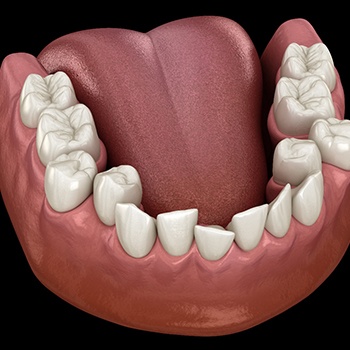
If there isn’t enough room in your mouth, your teeth will overlap, which is commonly referred to as “overcrowding.” This is one of the most common orthodontic issues and, fortunately, one that Invisalign can often correct. If you’re a candidate, then our Oak Cliff dentist, Dr. Martinez, will create a series of clear aligners to gently guide your teeth into their proper alignment. In some cases, the treatment process requires other steps, like interproximal reduction, to ensure that your teeth have the space to move.
Gaps Between Teeth

Some patients are struggling with the opposite problem: there is so much space in their mouth that there are considerable gaps between their teeth. If that’s the case for you, you’ll be happy to know that countless patients with this orthodontic issue have had success with Invisalign. Since the aligners are clear, you’ll even be able to watch as your teeth come closer and closer together, improving the look, health, and function of your smile in the process.
Overbite
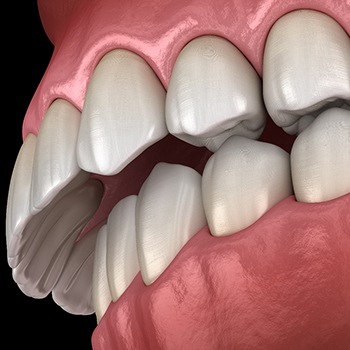
An overbite is when your upper teeth jut out beyond your lower teeth. If you have this orthodontic problem and you’re a candidate for Invisalign, we can use a series of clear aligners along with attachments, buttons, and rubber bands to bring your bite into proper alignment. Not only will this improve the appearance of your smile, but it will help prevent problems like TMJ dysfunction and chronic jaw pain from arising.
Underbite
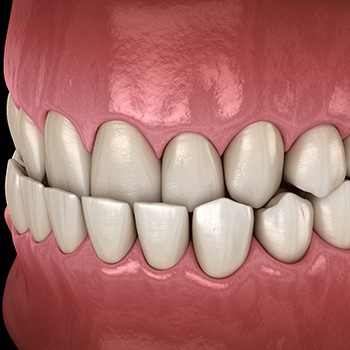
An underbite is when your lower teeth sit in front of your upper teeth. This bite problem puts immense pressure on your jaw, which is one of the many reasons we recommend exploring your orthodontic treatment options before chronic issues develop. The good news is that you may be a candidate for Invisalign, which will improve both the alignment of your jaw and the alignment of your teeth.
Crossbite
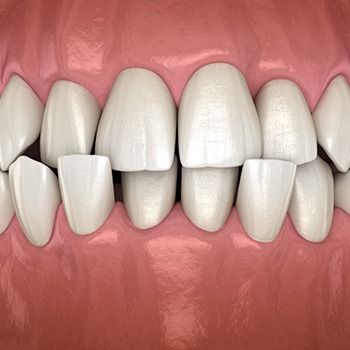
Some patients have a mix of an overbite and underbite. In other words, some of their lower teeth sit in front of their upper teeth and vice versa. One of the biggest concerns with this bite problem is that the weight of your bite isn’t distributed evenly, which can lead to premature wear and other issues. Fortunately, Invisalign can address mild and moderate cases of crossbites with the help of orthodontic accessories, like rubber bands.
Open Bite
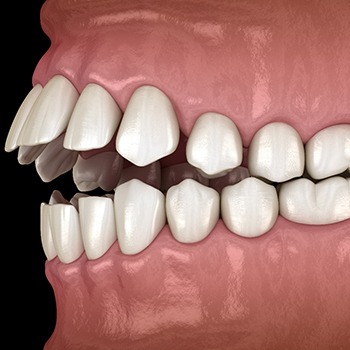
When you bite down, do your upper and lower teeth come together evenly? If they don’t, then you may have an open bite, which is often the result of genetics or a childhood habit, like thumb-sucking. Not to worry – this orthodontic problem can be fixed with braces. If you’re a good candidate for Invisalign, then we can even address it with a custom-made series of aligners so no unwanted attention is drawn to your smile!
What are the Benefits of Invisalign?
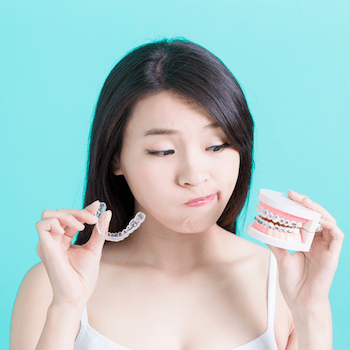
There are many benefits to orthodontic treatment using Invisalign clear braces, including:
- Speed – treatment can be completed in half the time that it takes to complete traditional bracket and wire orthodontic treatment.
- Comfort – without brackets and wires irritating soft tissue, Invisalign is significantly more comfortable than traditional orthodontic options.
- Minimal hassle – since you can remove your Invisalign trays during meals or to brush and floss, there’s no need to make changes to your diet or oral hygiene routine.
- Cosmetically flawless – you’ll be able to confidently share your smile in any situation with clear aligner trays, your smile will look beautiful throughout treatment.
Living with Invisalign Aligners

Wondering how your life will change once you start clear aligner treatment? Fortunately, the transition will be relatively easy, especially since you don’t have to worry about changing your diet or adopting an extensive oral hygiene regimen. Still, we’ve dedicated this next section to covering important information about living with Invisalign, so keep reading!
Wearing Your Trays

One of the biggest perks of Invisalign is that the clear aligners are removable. With that said, you still need to wear the aligners as much as possible. The general guideline patients are given is 20-22 hours a day. This ensures that you’ll have plenty of time to eat, drink, and complete your oral hygiene regimen while still wearing your aligners for the large majority of the day.
Tip: Use the Invisalign app to track your wear time!
Cleaning Your Aligners

Keeping your aligners in pristine condition requires some effort, including cleaning them after each meal. The good news is that you only need two things to do so: clean, cool water and a soft-bristled toothbrush. You should NOT use household cleaners, like bleach, since they contain toxins that are not safe to ingest. If you want to give your trays a deeper clean, use the cleaning crystals!
Eating & Drinking

As we mentioned in the first section, you won’t have to change your diet with Invisalign. In other words, you won’t have to eliminate whole apples, raw nuts, and other crunchy foods from your diet just because you have clear aligners. You will need to exercise caution, of course, since you want to avoid losing an attachment. Fortunately, there are lots of smile-friendly options that are also delicious, like plain yogurt, vegetable soup, and oatmeal.
Losing or Damaging a Tray

Instead of panicking, call our Oak Cliff dental team and explain what happened. We’ll ask you a few questions to learn more about your situation, like how severe the damage is, before taking a look at your treatment plan and determining what the next best steps are.
Note: If you’ve misplaced your aligners, try retracing your steps. If you feel like you’ve looked everywhere and they are nowhere to be found, then give us a call.
Routine Check-Ins
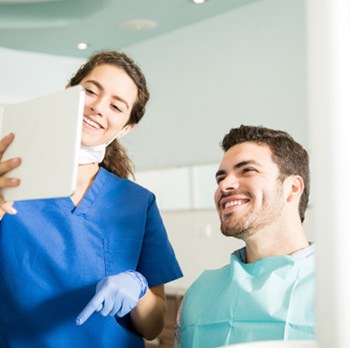
Throughout your clear aligner treatment, you’ll need to come to our office every six to eight weeks. That way, we can take new scans of your teeth and monitor how they are tracking. If for any reason they aren’t moving as anticipated, then we can make some recommendations to help get you back on-track, like using the chewies each time you put your aligners back on.
Who Should Consider Invisalign?

No treatment is right for every patient, so before we begin your Invisalign orthodontic plan, we’ll want to take the time to consider a number of factors, including:
- The severity of your orthodontic alignment issues. Invisalign is best used when treating minor to moderate orthodontic issues like over, under, and crossbite.
- Patients whose schedules make frequent, lengthy orthodontist appointments inconvenient or impossible.
- Patients with severe sensitivity in the teeth, gums, or gag reflexes may find regular bracket and wire adjustments too uncomfortable.
- Those with severe allergies or sensitivities to metal will need to consider an alternative to traditional metal bracket and wire treatments, and Invisalign may be a great option.
Understanding the Cost of Invisalign
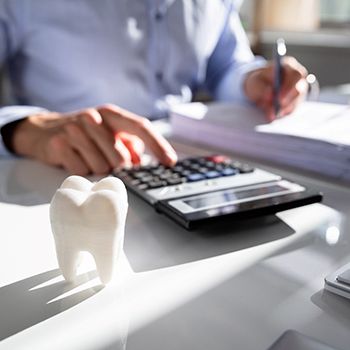
Are you tired of hiding your misaligned teeth every time you speak, smile, or laugh? If so, you may be thinking about getting Invisalign in Dallas. Before moving forward with the process, you likely want to know how much your overall treatment will cost. Since the answer varies from patient to patient, the only way to find out is by scheduling a consultation with Dr. Martinez. During your appointment, our team will explain which factors influence the total price and provide you with an accurate cost estimate based on your unique case.
Factors that Affect the Cost of Invisalign
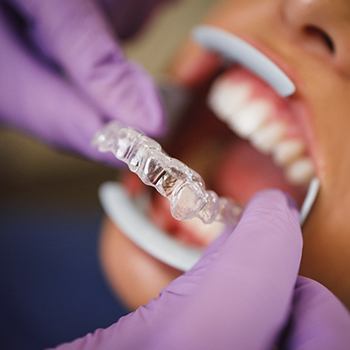
Since every smile is unique, the overall cost of Invisalign in Dallas will vary significantly depending on several factors. Some of those elements include:
- The number of aligners needed. This depends on the extent and type of dental misalignment you have.
- Whether you’re straightening one arch or both. Logically speaking, straightening both the upper and lower teeth will cost more than straightening just one or the other.
- Your treatment compliance. You will have to pay more to replace an aligner if you lose one.
- Whether you need additional accessories. Some patients will need elastics or other accessories to ensure successful treatment.
Invisalign vs. Smile Direct Club™: Which Costs More?

Do-it-yourself clear aligner treatments like SmileDirectClub™ have become increasingly popular in recent years! Many people on a budget are often tempted to opt for these alternative methods because they’re cheaper. While SmileDirectClub™ usually costs around $2,000, Invisalign may cost anywhere between $3,000 to $8,000. However, it’s important to keep in mind that you get what you pay for.
DIY aligner companies provide little to no oversight from a dental professional. As a result, plenty of things can go wrong throughout the treatment process, leading to issues that will need to be corrected by a professional anyway.
On the other hand, you can enjoy personalized support from our team throughout your Invisalign journey. Even though the overall price is higher, your aligners will be made from a patented material that’s designed for comfort and efficient tooth movements. Best of all, you can enjoy a smoother and more successful treatment process overall. Most people find that the quality is certainly worth every penny!
Does Dental Insurance Cover Invisalign?
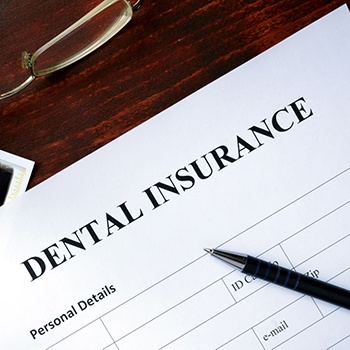
Some dental insurance plans include coverage for orthodontic treatment, and Invisalign is usually included. Of course, you’ll need to check with your insurance provider to find out if your plan can reduce your out-of-pocket expenses for treatment. If needed, our team will be more than happy to help you understand your coverage and maximize your benefits! You can also use your FSA or HAS to cover the cost of treatment instead.
Options for Making Invisalign Affordable

Don’t have dental insurance? No problem! We offer additional financing options that can help make your dental bills much easier to manage, including:
- In-Office Membership Plan – For one annual fee, you can get preventive dental care and a significant discount on many other dental services, including Invisalign.
- CareCredit Financing – With this option, you can split up the total cost of your treatment into smaller, budget-friendly monthly installments. Additionally, since there are several low-to-interest plans to choose from, you’re guaranteed to find something that’ll fit your budget!
Are you interested in learning more about Invisalign in Dallas? Give our office a call and schedule a consultation today! We’ll discuss your financing options and create a treatment plan that works best for you.
Invisalign FAQs
Whether you are a new patient or a longtime friend at this point, our team is excited to be a part of your journey to achieving your smile goals. If you are ready to schedule your initial consultation with our dentist in Oak Cliff and take the next step toward perfectly straight teeth, don’t hesitate to contact us! If you’d prefer to do a bit more research before reaching out, then keep reading for the answers to a few frequently asked questions we hear from patients.
Is Invisalign Treatment Painful?
Any orthodontic treatment, including Invisalign, is bound to come with some discomfort. After all, the aligners are designed to exert pressure on your teeth to gradually move them into their new position – so some soreness is completely natural! With that being said, Invisalign in Oak Cliff is designed with comfort in mind. While you may experience some irritation upon starting a new phase of treatment, the sensation typically wears off within a few days.
Will My Speech Be Affected by My Invisalign Aligners?
To form words, your tongue makes a series of distinct movements against the back of your teeth. So, while many patients don’t experience any difficultly enunciating, others have a bit of a learning curve. Fortunately, this is usually short-lived, lasting only a few days. Plus, you can speed up the process by reading aloud and practicing the more difficult words repeatedly.
Can I Chew Gum While Wearing My Invisalign Aligners?
No. To preserve their shape and keep your aligners in place, you should not chew gum while your trays are in. They should also be removed when you complete your oral hygiene routine, eat, and drink. To ensure you stay on track with your treatment plan, you should keep your aligners in otherwise (between 20 and 22 hours each day is recommended).
How Should I Clean My Invisalign Aligners?
Cleaning your aligners is an essential part of keeping them clear and discreet. To prevent staining, make sure to rinse them thoroughly after removing them from your mouth and before putting them back in place. You should also wash them with a soft-bristled toothbrush and lukewarm water or an Invisalign-friendly cleaner daily to keep them free of plaque, food particles, and bacteria. A few additional best practices include keeping them in a designated storage case while you eat (instead of placing them on the table or a countertop) and prioritizing your at-home dental care for your teeth and gums.
Ready to take the next step toward straight teeth? Couldn’t find the answer you were looking for here? Then now is the time to get in touch with our team. We can’t wait to help you achieve your dream smile!






